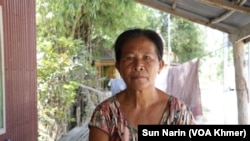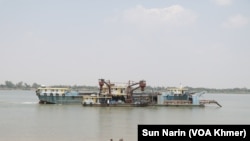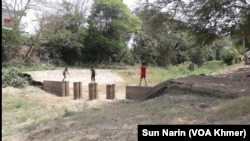Sok Srey is prepared for the Mekong River to rise in June, when its water spills into the Takeo, a small river or prek in Khmer, abutting the land she’s occupied with her family for almost a quarter of a century.
She is not prepared for what might happen to her family if a proposed China-funded canal connecting the Gulf of Thailand with inland tributaries of the Mekong River like the Takeo.
“I don’t have any clear information yet. I just heard that they are going to build here,” Sok Srey, 60, told VOA Khmer in March during an interview at her house, around 35 kilometers from Phnom Penh, Cambodia’s capital.
She and her fisherfolk neighbors have yet to hear from Cambodian authorities about what will happen to families impacted by the project.
Cambodia’s government approved the 180-kilometer-long Funan Techo Canal in May. The $1.7 billion project, part of the Chinese government's Belt and Road Initiative, would connect the coastal province of Kep with Kandal and Takeo provinces inland. The proposed design is 100 meters wide upstream and 80 meters wide downstream, with a consistent depth of 5.4 meters. It is the latest China-financed infrastructure project in Cambodia.
The proposed canal has alarmed neighboring Vietnam about how the project would affect its use of the flow of water downstream.
Brian Eyler, senior fellow and director of the Southeast Asia Program at the Stimson Center, said the costs and benefits of this project “are mostly unknown due to a lack of information.”
He added, “This project will likely have severe impacts on rice production in two of Vietnam's top rice-producing provinces and thus, the Vietnamese are justly worried.”
In December, Cambodian Prime Minister Hun Manet reassured Hanoi, saying the project “will not incur any negative impacts on the flow of the Mekong or other rivers while maintaining a stable environment, ecology and natural habitat for biodiversity.”
So far, there is no official reaction to the canal from the Vietnamese government, and the Vietnamese Embassy in Phnom Penh did not respond to VOA Khmer’s questions via email.
But such discord and diplomacy is far from Sok Srey’s workday life. In the months when she is not casting her nets in the Takeo, she picks chilies and clears grass, earning around $7.50 a day when she finds work. Her husband, Mov Sarin, 62, is a former soldier without a pension. Her daughter, Rin Sreyvy, is a 16-year-old ninth-grader.
Although Sok Srey is not the registered owner of the riverside land, she
feels that if the government wants the plot, it should compensate her and find her a place to live.
“I am worried, I couldn’t even sleep,” she said. “I don’t oppose the state, but if the state gives me a piece of land, I would appreciate that.”
Neighbors like Year Savun, a 58-year-old widow and mother of six who has lived on her mortgaged plot since 1984, and Tong Eng, 74, who owns a plot he has occupied since 1982, also don’t oppose the canal.
“The canal is good for the whole country, but where will people go to live?” asked Uot Kim Eng, 57, a roadside sugar cane and grocery seller who lives near Tong Eng.
Phan Rim, spokesperson of the Ministry of Public Works and Transport, told VOA Khmer on March 18 the project’s impact has been “primarily studied,” but “we’re still studying it more thoroughly.”
The Ministry of Economy and Finance, he added, will study the compensation issue to ensure the government follows proper procedures and the villagers will be consulted.
The China Road and Bridge Corporation (CRBC), one of China’s giant state-owned companies, is backing the project via a build-operate-transfer (BOT) contract, according to Cambodia’s Ministry of Public Works and Transport. If completed, it would reduce the transit time between the ports in Sihanoukville and Phnom Penh, according to the ministry.
Under the BOT, the Chinese company would build the canal, maintain and manage it and profit from charging for passage through the canal for some 50 years before it would revert to Cambodia.
On March 12, Hun Manet said the canal will create jobs for the 1.6 million people who live along the proposed route, and Cambodia’s government says construction will begin later this year.
Rim Sokvy, an independent researcher in Cambodia, wrote in an analysis published on ThinkChina, a Singapore-based website, that the canal “could steer Cambodia away from Vietnam and towards China.”
He said Cambodia now relies heavily on the Vietnamese waterways for importing raw materials from China and exporting finished products to the U.S. and Western countries.
“Vietnam will lose significant income … as Cambodia starts to depend on its own waterway transportation. The construction of the Funan Techo Canal is showing a decrease of Vietnam’s influence on Cambodia. This will be Hun Manet’s legacy,” Rim Sokvy said.
Phan Rim said the Mekong option will be unchanged.













